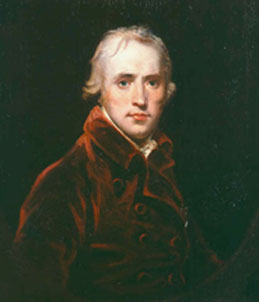| John Hoppner  Born: 4-Apr-1758 Born: 4-Apr-1758
Birthplace: London, England
Died: 23-Jan-1810
Location of death: London, England
Cause of death: unspecified
Gender: Male
Race or Ethnicity: White
Occupation: Painter Nationality: England
Executive summary: English portrait painter English portrait-painter, born, it is said, on the 4th of April 1758 at Whitechapel. His father was of German extraction, and his mother was one of the German attendants at the royal palace. Hoppner was consequently brought early under the notice and received the patronage of George III, whose regard for him gave rise to the unfounded scandal that he was the sovereign's son. As a boy he was a chorister at the royal chapel, but showing strong inclination for art, he in 1775 entered as a student at the Royal Academy. In 1778 he took a silver medal for drawing from the life, and in 1782 the Academy's highest award, the gold medal for historical painting, his subject being King Lear. He first exhibited at the Royal Academy in 1780. His earliest love was for landscape, but necessity obliged him to turn to the more lucrative business of portrait painting. At once successful, he had, throughout life, the most fashionable and wealthy sitters, and was the greatest rival of the growing attraction of Sir Thomas Lawrence. Ideal subjects were very rarely at tempted by Hoppner, though a "Sleeping Venus", "Belisarius", "Jupiter and Io", a "Bacchante" and "Cupid and Psyche" are mentioned among his works. The prince of Wales especially patronized him, and many of his finest portraits are in the state apartments at St. James's Palace, the best perhaps being those of the prince, the duke and duchess of York, of Lord Rodney and of Lord Nelson. Among his other sitters were Sir Walter Scott, Wellington, Frere and Sir George Beaumont. Competent judges have deemed his most successful works to be his portraits of women and children. A Series of Portraits of Ladies was published by him in 1803, and a volume of translations of Eastern tales into English verse in 1805. The verse is of but mediocre quality. In his later years Hoppner suffered from a chronic disease of the liver; he died on the 23rd of January 1810, He was confessedly an imitator of Joshua Reynolds. When first painted, his works were much admired for the brilliancy and harmony of their coloring, but the injury due to destructive mediums and lapse of time which many of them suffered caused a great depreciation in his reputation. The appearance, however, of some of his pictures in good condition has shown that his fame as a brilliant colorist was well founded. His drawing is faulty, but his touch has qualities of breadth and freedom that give to his paintings a faint reflection of the charm of Reynolds. Hoppner was a man of great social power, and had the knowledge and accomplishments of a man of the world. The best account of his life and paintings is the exhaustive work by William McKay and W. Roberts (1909).
University: Royal Academy, London
Do you know something we don't?
Submit a correction or make a comment about this profile
Copyright ©2019 Soylent Communications
|